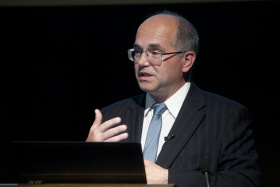The intensively raised goat and the organic cabbage – can we have our cake and eat it? New report on regenerative agriculture presented at MTA by the Scientific Advisory Board of the European Academies
Agriculture is one of the most environmentally damaging of human activities, fundamentally changing the appearance and ecological structure of the landscape, including the composition of ecosystems, and is responsible for emitting huge amounts of carbon dioxide into the atmosphere. Despite this, transforming agriculture is, believe it or not, a task even more difficult than industrial reform, as the importance of food production makes it virtually untouchable in the eyes of many, and current large-scale producers often see ecologists as adversaries rather than partners. Yet, according to the latest report of the Scientific Advisory Board of the European Academies (EASAC) on regenerative agriculture, not only is ecologically sensitive agriculture not an enemy of food production but, due to climate change and environmental degradation, it will, in a few short decades, represent our only chance of being able to feed humanity. To explore the background of the report presented at the Hungarian Academy of Sciences on Wednesday 6th of April, we interviewed two Hungarian members of the scientific community who were behind it – Orsolya Valkó and András Báldi.
A significant portion of the environmental problems of our time are related to agriculture. “Already in agriculture, we’ve crossed the red lines that represent the limits of the planet’s regenerative capacity many times – lines that should not be crossed if we’re serious about not wanting to destroy land-based ecosystems”, said András Báldi, scientific adviser to the Institute of Ecology and Botany of the Ecological Research Centre and member of the EASAC’s Environment Steering Panel. The environmental damage wrought by agriculture has numerous components to it, but particularly conspicuous are increasing land use, biodiversity loss, drastic disruption of nitrogen and phosphorus cycles, and water usage, which in some areas have now exceeded the planet’s carrying capacity.
 András Báldy Fotó: mta.hu/Tamás Szigeti
András Báldy Fotó: mta.hu/Tamás Szigeti“If we succeed in transforming agriculture so that it does not cross these ecological red lines but still remains viable, we could eliminate a significant proportion of our environmental problems without having to starve,” continues András Báldi.
The climate impact of intensive agriculture is huge, as it is responsible for a third of all carbon emissions and uses vast quantities of fossil fuels to supply its energy needs. And the use of chemicals can result in a permanent reduction in biodiversity.
The ecologist cited his own team’s research, in which
they compared the bee fauna of hyper-intensively cultivated Dutch grasslands (which are more like heavily fertilised lawns) with the bees of
the near-natural grasslands of Hungary’s Kiskunság region. The result was that while Hungarian grasslands play host to 126 different bee species, only four species live on the Dutch grasslands.
Of course, the other side of the coin is that the productivity of Dutch agriculture is much higher than that of Hungary’s. So, the big question, says Báldi, is
whether we can have our cake and eat it or, to paraphrase the Hungarian equivalent, feed our intensively raised goat and keep our organic cabbage – in other words, whether we can protect the environment from the damaging effects of agriculture without reducing food-production productivity.
Several solutions have been offered to address this problem over the past decades, but few of these ideas have been put into practice. The EASAC’s report on regenerative agriculture was written to provide policy advice to European decision-makers on the practical steps that need taking. The reforms will not be easy to push through, as perhaps no industry has the same lobbying power as the farming sector.
The European Union’s climate change strategies have huge potential, but researchers also acknowledge that if all their objectives were to be achieved there would be less space for food production than is needed.
Therefore, the current EASAC report also aims to put a number of options on the table for the implementation of regenerative agriculture (i.e. ensuring the survival and renewal of natural habitats and the ecosystem services they provide), and
these options can be chosen flexibly by farmers and the ecologists who work with them, in accordance with local needs and opportunities.
 Orsolya Valkó Fotó: mta.hu / Tamás Szigeti
Orsolya Valkó Fotó: mta.hu / Tamás Szigeti“Diversifying agricultural production has been shown to be very good for biodiversity and ecosystem services, and can even increase production efficiency,” said Orsolya Valkó, also a scientific advisor to the Institute of Ecology and Botany of the Ecological Research Centre and co-chair of EASAC’s regenerative agriculture working group. “In the report, we’ve placed great emphasis on suggesting what changes can be applied and where, and where they might not be so beneficial. The difficulty in this problem lies in the fact that agriculture and wildlife would essentially like to use the same area and the same resources.”
Our message is that in places where protecting biodiversity is the priority, it is the latter aspects that need to be taken into account, while in areas whose purpose is essentially agricultural, the emphasis should be on food production.”
Agriculture can still be practiced to a certain extent in areas of high priority for biodiversity, argue the researchers, but in these cases the emphasis should not be on the quantity of the produce, but on its quality.
The concept of regenerative agriculture is very flexible: it allows for a wide range of methods provided that the intervention results in viable agricultural production of a kind that also contributes to the protection of biodiversity and the reduction of climate change. These objectives can be achieved through a number of processes depending on the features of the area concerned. There are places where reducing or eliminating ploughing is the right method, or where ensuring there is green cover on the land during the entire growing season is important.
In many places, it is worth diversifying agricultural areas in time and space, through crop rotation or intercropping (growing a crop among plants of a different kind, usually in the space between rows).
Biodiversity can also be enhanced through a forest-agriculture mosaic – alternating between arable fields and patches of managed woodland.
The report found that these methods already yield very promising results even at the individual experimental-farm level, but that they would bring systemic improvements if they could be applied in a coordinated manner. If for example there is a coordinated planting of flower strips in a particular area, this would, as the research of the Centre for Ecological Research has demonstrated, have a highly beneficial effect on the functioning of the entire landscape. The beneficial effects will be felt not only on the land of the farmer concerned, but on a much larger scale.
“One of our suggestions is that it would be beneficial to develop support schemes that encourage farmers to make ecological changes not just on their own, but by forming communities. This would result in a greater level of success”, continued Orsolya Valkó. “And I mean success in terms of agricultural production as well as ecosystem preservation. In the short term, these two aims may clash to some extent, but if we can maintain soil health, preserve water and sequester carbon dioxide we will not only benefit living things, but will be able to carry on agricultural production in the area fifty years from now.
But a compromise will always need to be struck, because none of the parties can expect to simply carry on doing the same things they’ve always done and get the same results.”
A complete overhaul of the system is needed in agriculture if food production is to be placed on a sustainable footing.
Until recently, the European Union’s strategies had given good grounds for hope that prosperous societies which had enjoyed a long period of peace could devote resources to this. But now there is a fear that the war in Ukraine may have changed everything.
“Two major producing countries, Russia and Ukraine, have effectively dropped out of the world’s food supply, and already voices can be heard saying that all ecological reforms should be postponed and that only production matters, because otherwise we will soon find ourselves with nothing to eat.
We’re hearing arguments that were prevalent in the West half a century ago,” warns András Báldi. “Which is particularly worrying given that now is precisely the time that the transformation could be implemented a lot more quickly and agricultural production could be brought into line with local conditions. Not only would we save years through this, but we could greatly reduce agriculture’s dependence on hydrocarbon and fertiliser exports, as well as its use of fertilisers. And in this way, we could help implement the Paris climate goals while at the same time reducing our energy exposure, which would have obvious national security benefits.”
You can read the EASAC’s report here.
